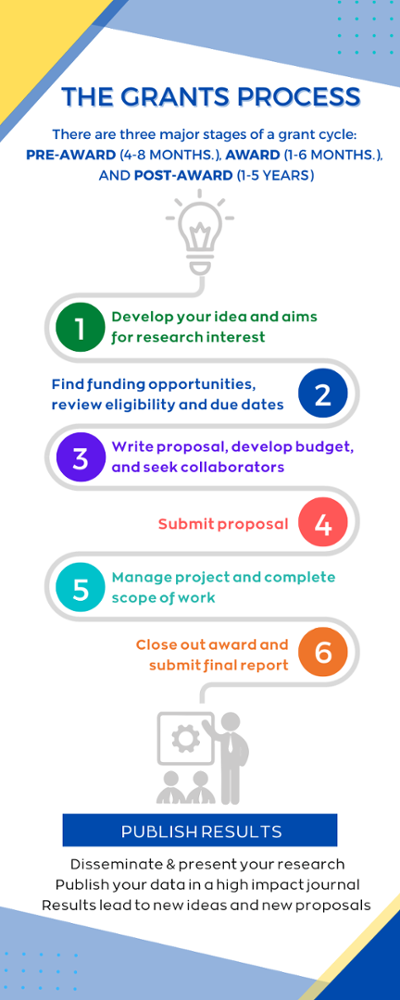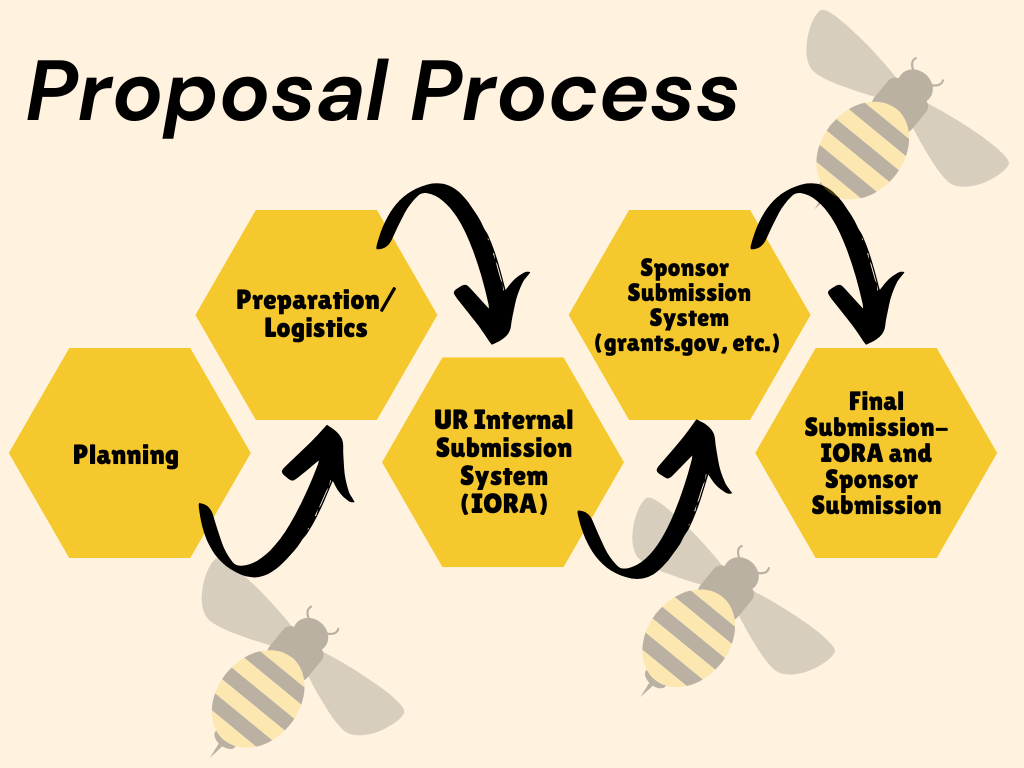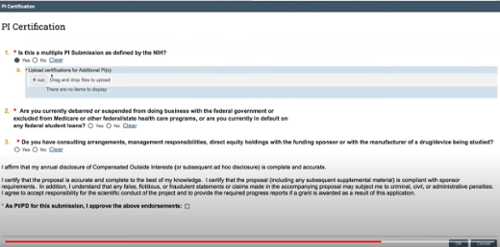Proposal Development

Grant Process
There are three major stages to the grant cycle:
- Pre-award: This can take anywhere from four to eight months, and includes developing ideas, finding funding opportunities, working with collaborators, and writing and submitting the proposal.
- Award: It may take up to six months for the funding agency to go through their review process and offer an award. It will take additional time for the award to be set up with the business office before you are ready to hit the ground with your project. The project itself may be up to five years in duration or longer if a no cost extension is granted.
- Post award: After the project had been completed, you’ll need to submit your final report and expenses. The research that you complied here can also be disseminated and submitted to high impact journals, and even lead to new ideas and proposals over the next several years.
Within these stages, faculty will complete the following steps:
- Develop your idea and aims for research interest
- Find funding opportunities, review eligibility and due dates
- Write proposal, develop budget, and seek collaborators
- Submit proposal
- Manage project and complete scope of work
- Close out award and submit final report publish results
Proposal Process

Planning
When looking over the funding opportunity be sure to determine:
- If it is an internal limited submission opportunity (If it is, follow the limited submission opportunity process)
- If there a letter of intent/pre-application required and if so when the due date for the first submission is
- What the due date of the full proposal is
During the planning phase, the PI will determine who, if anyone, should be engaged as partners or collaborators (subawards). The PI will work with their research administrator of assistant dean of grants and contracts to review and understand the submission requirements. A submission timeline should be determined. It is recommended that the PI discuss the submission with their chair and seek preapproval for the project idea to ensure adequate department resources exist to support the project.
Preparation/Logistics
Before you start the process of submitting your proposal, we recommend working with your department research administrator (RA) or assistant deans for AS&E to disclose any cost share, animal research, human subjects research, etc. You’ll also want to determine what, if any internal resources are needed for the project to succeed.
During the logistical phase of the proposal development, PIs write the technical proposal, develop the budget and budget narrative, and determine if the project will need additional resources such as equipment and space. Work with your research administrator to determine if an ancillary review is needed based on the below questions.
- Is there indirect cost share across schools within UR? F&A cost-sharing (two or more schools have costs on a project in ASE)?
- Is there mandatory or involuntary cost share identified in the budget?
- Does this project require new space on campus?
- Does this project use a lower indirect rate than institutional rate without justification from sponsor (lower rate explicit in RFA or on website)?
- Will more than 50 percent of the work (time and effort) be conducted off-campus and therefore the off-campus indirect rate used?
- Is there SBIR or SB Tech Transfer?
- Program projects (P01), center grants (P50 or P60), or other similar?
- Are the total direct costs less than $500,000 per year?
- Is the department chair also the PI?
- Is the PI outside of the University of Rochester’s stated policy for PI?
If an ancillary review is required, reach out to the assistant deans of grants and contracts so they can gain approval for the project.
UR Internal IORA Submission
The University of Rochester uses an online system for grants and agreements called Integrated Online Research Administration (IORA). IORA is a comprehensive suite of software solutions to manage research functions. This site helps the University track grant submissions, subawards, and manage approvals. Therefore, for all proposals, you must create an IORA project submission. The ORPA site has more information on IORA along with training and an FAQ page.
Therefore, for all but a few unique circumstances, proposals must be routed through the IORA system.
We recommend anyone using the IORA system take the IORA training.
IORA System Notes for Research Administrators
Senior personnel identified in a proposal will need an IORA user account. This may take up to 48 hours (request an IORA user account).
A project that includes subawards will need to identify that subaward in the IORA system. If the subaward entity is not listed, contact your ORPA representative with the subaward EIN or other identifier to be added to this system. You can add a placeholder (TBD) until the subaward entity has been entered into the IORA system. At this point, you will need to go back and identify them before submitting your proposal for review.
Once the IORA submission is completed, it will be sent to the department chair for review and approval.
Helpful Hints for IORA
Reminder that a PI certification is necessary for all proposals. If the RA is submitting on behalf of a PI, ensure that the PI knows how to access the system and click ‘PI Certification’.


The system will ask for a short title. The best practice here is to enter the- sponsor, PI Name, brief description. Example: NSF, Mosher, Website enhancements to increase proposal development effectiveness.
Using system to system? At this time, we are NOT using the system-system submissions.
Sponsor Electronic Submission
Once the IORA submission is routed for approvals, the next step is the sponsor submission system. This will vary depending on which funding agency is being used. The funding announcement will have specific instructions on how to submit your proposal for funding. Check with the assistant deans for AS&E with any questions or concerns regarding submission requirements.
Often, the sponsor submission system will require the PI to have a user account. If you have not created one, or it has been a long time since you’ve used on, you will need to request and account or retrieve your account information. This may take up to a week to resolve. Ensure your log in credentials are correct at the proposal development stage.
Once you are logged in, start entering the information about your project in the workspace. Many workstations allow you to add an administrator to the proposal. Add your assistant deans and RAs to the system so that we can review your documents for consistency with the funding announcement.
Upload the required documents such as biosketches, current and pending funding, etc. Each funding announcement will have specific requirements regarding what documents and appendices are necessary to submit. Your assistant deans can help by creating a checklist of requirements.
Give access to ORPA who will complete the final submission.
Final Submission- IORA and Sponsor Electronic Submission Site
Final submission will occur after department review and PI certification. The IORA submission will be routed for specialist review (ORPA) and identify errors that should be corrected before the final submission. Once the errors (if any) are resolved, the specialist (ORPA) will check with the PI to ensure proposal is complete in sponsor workstation and submits the final proposal in the sponsor electronic system.
